Hawaii Reef Fish Guide for Snorkelers
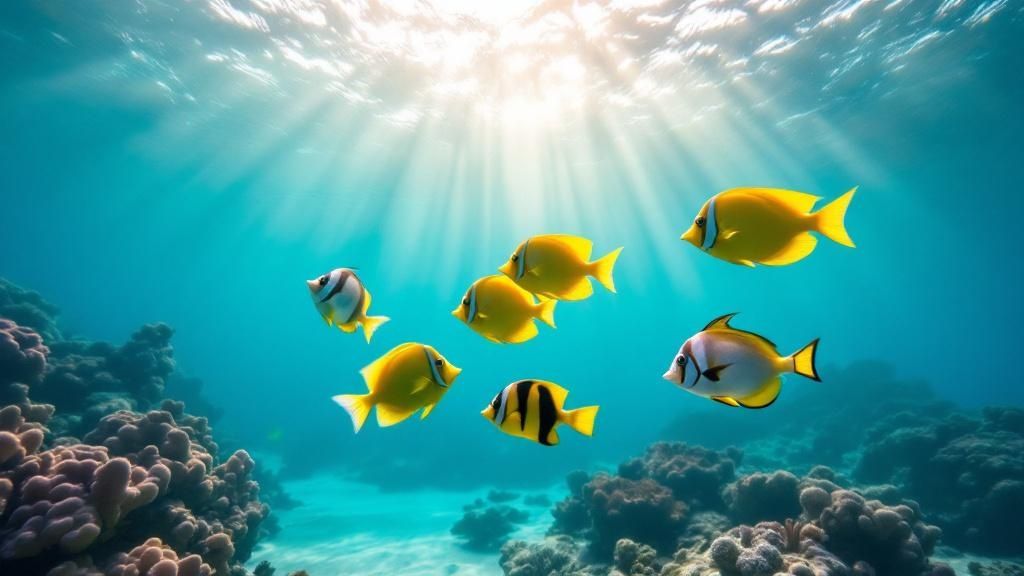
Ready to turn your next snorkel trip into a real discovery adventure? This guide is your key to identifying the incredible variety of fish that call Hawaii's reefs home. We'll go beyond just spotting bright colors and help you recognize the specific species that make these waters so unique, from the famous Humuhumunukunukuāpuaʻa to the dazzling Yellow Tang.
Your Guide to Hawaii's Underwater World
Welcome to your go-to reference for Hawaii's amazing reef fish. My goal here is to help every snorkeler, whether you're just starting out or have been at it for years, move past simply seeing fish to actually recognizing and appreciating them. It’s this deeper connection that transforms a fun swim into a truly memorable experience.
The Hawaiian Islands are some of the most isolated spots on the planet, a fact that has led to a remarkable and fragile marine ecosystem. This incredible isolation allowed species to evolve here that you won't find anywhere else on Earth.
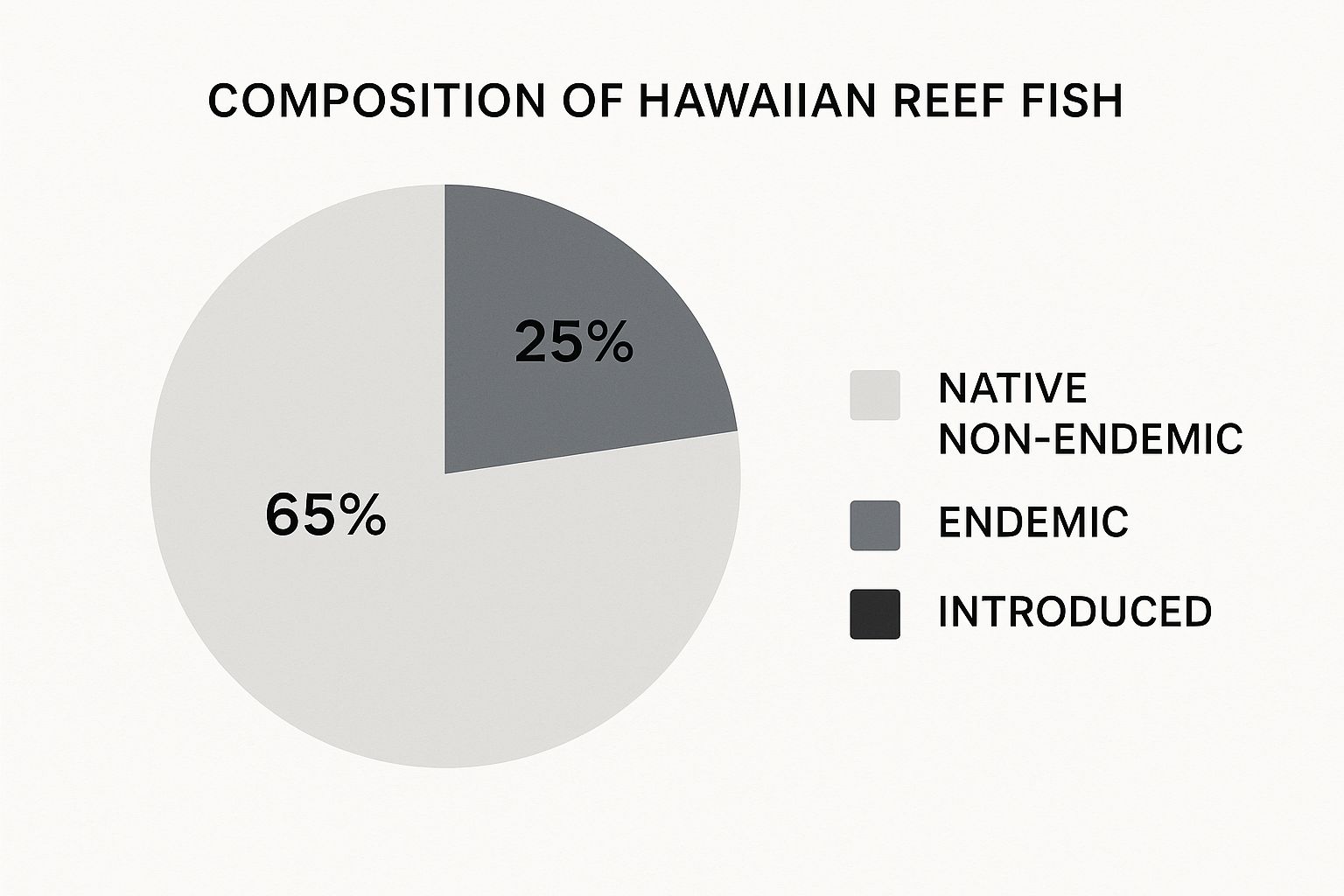
As you can see, roughly 25% of the reef fish here are endemic, which means Hawaii is the only place in the world they exist. This makes our job of protecting them incredibly important.
Understanding Reef Diversity
While hundreds of species cruise these waters, you'll quickly notice that a smaller, core group of fish are seen almost everywhere. This is actually a very common pattern in healthy, thriving reef ecosystems. For a closer look at where you can find these fish, check out our guide to the best spots for Big Island snorkeling.
To give you an idea, recent scientific surveys in South Kona documented over 140 different species. But get this: the top 20 most common species made up about 90% of all the individual fish counted. This data, from a detailed 2021 reef fish survey, shows just how quickly you can get a handle on identifying the reef's most frequent residents.
By learning to identify just a handful of the most common fish families, you'll be able to name the vast majority of fish you encounter on any given snorkel. It's a great feeling.
This guide is structured to help you do exactly that. We'll kick things off with a quick-reference table for the most common fish families before diving deep into detailed profiles of individual species.
Quick Reference for Common Hawaiian Fish Families
To get you started, here's a quick lookup table of the fish families you'll see most often. Think of this as your cheat sheet for quickly narrowing down what you're looking at.
| Fish Family | Key Identifying Feature | Common Habitat | Example Species |
|---|---|---|---|
| Butterflyfish | Thin, disk-shaped body; often in pairs | Coral-rich areas | Ornate Butterflyfish |
| Wrasses | Cigar-shaped body; swim with pectoral fins | Everywhere on the reef | Saddle Wrasse |
| Surgeonfish | Oval body with a scalpel-like spine at tail base | Grazing on algae over rock and coral | Yellow Tang |
| Parrotfish | Fused teeth form a "beak"; often colorful | Scraping algae from coral and rock | Spectacled Parrotfish |
| Triggerfish | Diamond-shaped body; prominent "trigger" spine | Often found near holes and ledges | Humuhumunukunukuāpuaʻa |
| Damselfish | Small, oval-shaped body; often territorial | Near their specific patch of coral | Hawaiian Dascyllus |
This table should give you a solid foundation. Now, let's get ready to meet the colorful characters of Hawaii's underwater neighborhoods in more detail.
A Guide to Identifying Butterflyfish
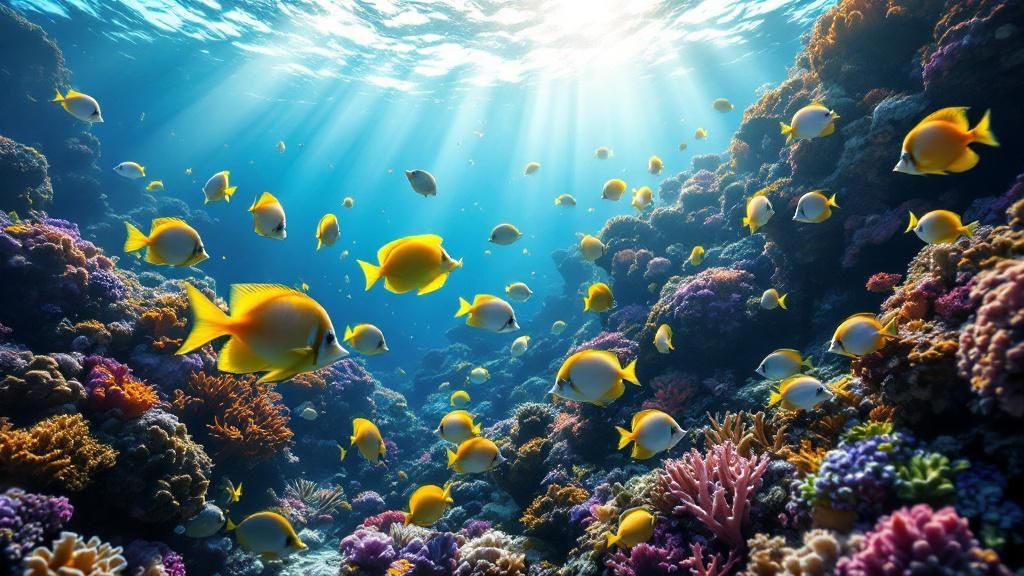
Of all the fish you’ll see fluttering around the Hawaiian reef, butterflyfish are often the first ones snorkelers get to know by name. Think of them as the graceful dancers of the sea. Their thin, disc-shaped bodies and incredibly vibrant patterns make them impossible to miss. You’ll usually see them dipping and weaving delicately over the coral, using their tiny, puckered mouths to peck at coral polyps and other small critters.
One of the coolest things to watch for is their social behavior. Many species form lifelong, monogamous pairs, and seeing two of them moving in perfect unison is a truly special sight on the reef. But they're more than just a pretty face; their presence tells a story. Since many butterflyfish feed directly on coral, a healthy population of them is a great sign that the coral ecosystem is thriving. In that way, they act as a living barometer for the health of the reef.
Common Butterflyfish Species in Hawaii
While there are quite a few species here, you can feel like a seasoned pro just by learning to spot a few of the most common ones. Each has its own distinct markings, and once you know what to look for, telling them apart gets much easier.
A neat trick many butterflyfish use to fool predators is a "false eyespot"—a dark, prominent spot near their tail. This is a brilliant defensive strategy. It tricks predators into aiming for the tail instead of the head, giving the fish a much better shot at escaping an attack.
Snorkeler's Tip: When you're trying to ID a butterflyfish, zero in on the specific patterns. Does it have a black bar running through its eye? Are there bold stripes or tiny spots? These fine details are usually the key, sometimes more so than the fish's overall color.
Here are a few of the key players you're almost certain to meet in Hawaiian waters:
- Fourspot Butterflyfish (Chaetodon quadrimaculatus): This is one of the most common butterflyfish you'll encounter. It has a sunny yellow upper body that darkens to a blackish-brown on its lower half. As its name suggests, the dead giveaway is the two obvious white spots on each side of its body.
- Milletseed Butterflyfish (Chaetodon miliaris): This one is special because it's endemic to Hawaii—you won't find it anywhere else on Earth! It’s easy to spot, with a bright yellow body covered in neat, vertical rows of little black dots that look just like millet seeds.
- Bluestripe Butterflyfish (Chaetodon fremblii): Another local treasure found only in Hawaii. This fish is absolutely stunning. Its yellow body is adorned with gorgeous horizontal blue stripes, making it one of the most striking and memorable fish on the entire reef.
Getting to know these species is a fantastic first step. If you're ready to dive deeper and learn about other fish families, check out our complete Hawaiian fish identification guide. It’s packed with more profiles and tips to help you make the most of your time in the water.
A Guide to Identifying Surgeonfish
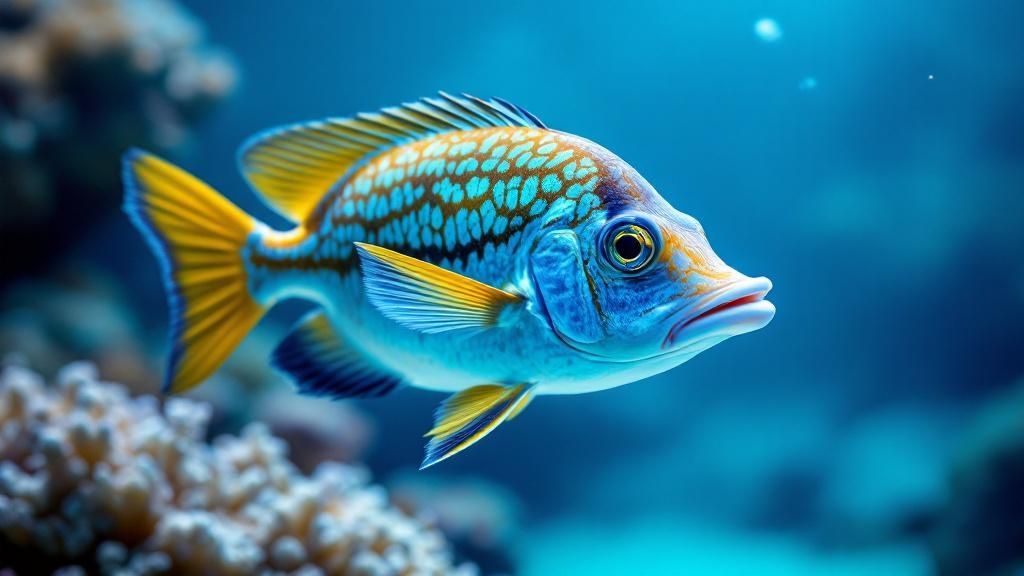
Of all the fish families you'll see grazing on Hawaii’s reefs, Surgeonfish are some of the most essential and easy to recognize once you know what to look for. Locally, we call them tangs, and their family name comes from a pretty remarkable defensive tool they all share. Tucked into a small groove on each side of their body, right where the tail begins, is an incredibly sharp spine that acts like a tiny scalpel.
When a surgeonfish feels threatened, it can flick this spine outward as a serious warning to any would-be predators. It’s a defense mechanism you’ll want to observe from a respectful distance, of course. Spotting this feature is the single best way to confirm you’re looking at a member of the Acanthuridae family. These fish are the reef’s tireless gardeners, constantly munching on algae that could otherwise smother fragile corals, making them absolutely critical to the reef's health.
Key Surgeonfish Species to Identify
You’ll find many different surgeonfish species swimming in Hawaiian waters, but getting to know a couple of the most common ones will give you a great head start. Their unique shapes and behaviors make them standout characters in any underwater scene.
Yellow Tang (Lauʻīpala)
This might just be the most famous of all Hawaiian surgeonfish. Seeing a Yellow Tang is like spotting a bolt of pure sunshine darting through the water. Their solid, electric yellow body is unmistakable against the dark volcanic rock and deep blue of the ocean. They’re super social and often move in large, loose schools, sweeping across the reef flats like a vibrant yellow cleaning crew.
- Identification: Look for that bright, solid yellow oval-shaped body. You can also spot a small, white scalpel at the base of the tail.
- Behavior: These guys are active grazers, constantly picking at turf algae. You'll almost always see them traveling in groups.
Convict Tang (Manini)
The Convict Tang, or Manini, is one of the most abundant fish you'll encounter on shallow Hawaiian reefs. It’s easy to see how they got their name—their silvery-white bodies are marked with five to six bold, vertical black bars, just like an old-fashioned prison uniform. Manini often form massive schools, sometimes numbering in the hundreds, as they graze together over rocky areas.
- Identification: A white or pale gray body with very distinct, vertical black stripes.
- Behavior: Famous for forming huge, impressive schools that move as one across the reef. It's quite a sight to see!
Stewardship Insight: While surgeonfish are plentiful, they aren't invincible. Many of the longer-lived species, including some surgeonfish, are especially vulnerable to overfishing. Their health is a direct indicator of the reef’s overall balance, so their populations tell us a lot about what’s happening underwater.
Their importance and long life cycles unfortunately make them susceptible to fishing pressures. A 2015 assessment of exploited reef fish in Hawaii revealed that nearly half of the species studied showed signs of being overfished, with surgeonfish being among the most vulnerable. This really highlights how vital responsible observation and conservation efforts are for their survival. You can learn more by checking out the findings on reef fish populations.
A Guide to Identifying Parrotfish
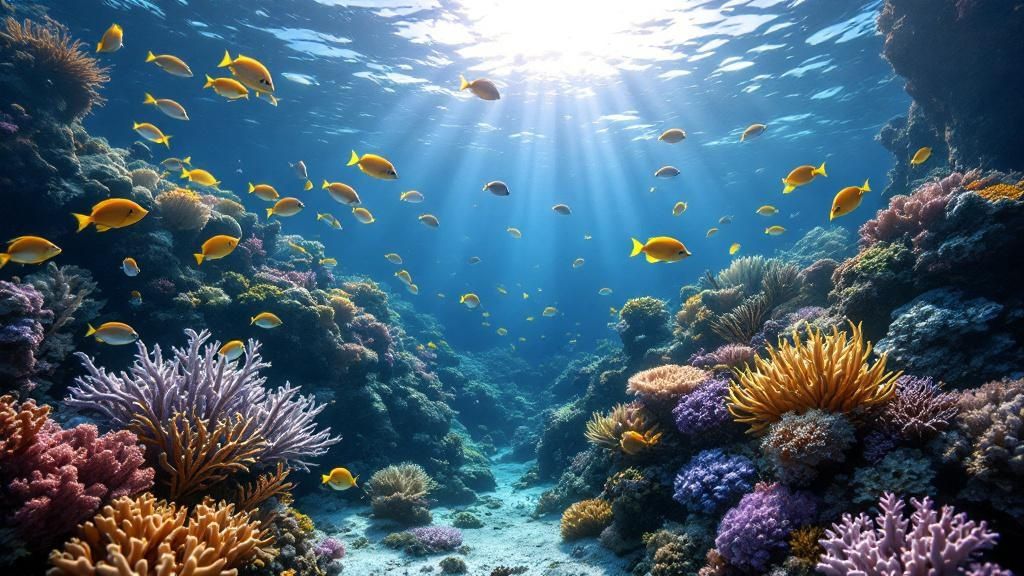
Parrotfish, or uhu in Hawaiian, are some of the most vibrant and vital fish you'll encounter on the reef. Ever hear a distinct crunching sound while you're snorkeling? There’s a good chance an uhu is nearby, hard at work.
Their name comes from their most obvious feature: teeth fused into a powerful, beak-like mouth. They use this specialized tool to scrape algae right off coral and rock. It's a behavior called bioerosion, and it’s absolutely essential to the health of the entire ecosystem.
As they digest the algae, they also process the inorganic coral skeleton they scraped up with it. What comes out the other end is fine, white sand—a huge reason Hawaii has such famous beaches. When you understand that connection, every parrotfish sighting becomes a real-time lesson in how the reef builds and sustains itself.
But here’s the tricky part: identifying individual parrotfish can be tough because they are masters of disguise. Many species change their color, patterns, and even their sex as they get older. The drab, reddish-brown initial phase female of a species can look like a totally different fish compared to the brilliant, multi-colored terminal phase male.
Common Parrotfish Species to Know
Instead of getting hung up on color alone, I've found it's much more helpful to focus on body shape and behavior. The two species below are common sights and perfect examples of parrotfish diversity. Once you know what to look for, you'll start spotting them everywhere.
Spectacled Parrotfish (Uhu-uliuli)
You’ll see this one all over Hawaiian reefs. The terminal phase male is a real showstopper with a deep blue-green body and unique pink markings around its mouth and eyes, which look just like a pair of spectacles.
- Identification: On the big, colorful males, look for those "spectacles." The initial phase fish are more mottled and reddish-brown and you'll often see them in groups.
- Behavior: These guys are constantly grazing over coral rubble and rocky bottoms, often in schools mixed with other fish.
Redlip Parrotfish (ʻĀʻā)
Another key species, the Redlip Parrotfish, stands out for its large size and distinct look. The initial phase is a dark, reddish-brown, but the terminal male transforms into a greenish fish with a big purple or blue patch on its cheek and, you guessed it, bright red lips.
- Identification: The reddish lips are a dead giveaway for the terminal phase. Its large, blunt head is also a good clue at any stage.
- Behavior: You'll often find these in deeper reef channels, using that powerful beak to take big bites out of the corals.
Conservation Focus: The Redlip Parrotfish is one of the species that's vulnerable to overfishing because it grows slowly and lives for a long time. Giving these incredible sand-producers plenty of space ensures they can keep doing their job, maintaining the health and structure of Hawaii’s reefs for generations to come.
Getting to know these key species is one of the most rewarding parts of any snorkeling trip. Understanding their lifecycle and ecological importance adds a much deeper appreciation for your adventures, connecting you directly to the processes that shape Hawaii's magnificent underwater world.
When you're out on a Hawaiian reef, you're bound to meet the wrasse family. They are one of the most common and varied groups of fish you'll see, zipping around in a dizzying array of shapes, sizes, and colors. Getting to know them is a fun challenge, and this guide will help you spot these energetic swimmers and learn a bit about their fascinating lives.
The first trick to spotting a wrasse is to watch how it swims. Most fish use their tails for power, but wrasses are different. They propel themselves by flapping their pectoral (side) fins, which gives them a distinctive "flying" motion through the water. Once you recognize this movement, you'll start seeing them everywhere, from the shallow reef flats to the deeper ledges.
Common Wrasse Species and Their Roles
Many wrasses are masters of disguise, changing their appearance dramatically throughout their lives. A juvenile can look like a completely different species from an adult, and many females can transform into brilliantly colored males later in life. Because of this, focusing on body shape and behavior is often a better bet for identification than relying on color alone.
- Saddle Wrasse (hīnālea lauwili): This is probably the most common fish you'll encounter on Hawaiian reefs. You'll know it by its greenish body, bluish head, and that impossible-to-miss reddish-orange "saddle" right behind its pectoral fin. They are in constant motion, so you’re almost guaranteed to spot one on any snorkel trip.
- Hawaiian Cleaner Wrasse: Don't let its small size fool you; this industrious little fish is a giant in terms of reef health. They run "cleaning stations" where bigger fish, from turtles to tangs, patiently line up to have parasites and dead skin nibbled away. Witnessing one of these stations in action is a real treat and a true highlight of any underwater adventure.
This relationship with the Hawaiian Cleaner Wrasse is a perfect peek into the intricate web of life on the reef. These tiny fish provide an absolutely essential service, and in return, they get a reliable meal.
Snorkeler's Insight: Want to find a cleaning station? Keep an eye out for a prominent coral head or rock where larger fish are hovering strangely still, sometimes with their mouths agape. Look closely, and you'll likely spot one or two small, slender wrasses darting around them, busy with their work.
Another fascinating species is the Dragon Wrasse. In its juvenile stage, it's a showstopper, with elaborate, flowing fins and a mottled pattern that helps it blend in with seaweed. But as it gets older, it undergoes a massive transformation into the much beefier Rockmover Wrasse, known for its habit of flipping over rocks to hunt for food underneath.
Taking the time to understand these life stages and behaviors is what makes identifying the wrasse family so rewarding. Their constant movement and wild transformations add a whole new layer of discovery to your snorkeling experience.
Practicing Responsible Reef Stewardship
Knowing the names of Hawaii’s reef fish is a great first step, but the real journey begins when you decide to become their protector. It’s all about embracing kuleana, a powerful Hawaiian value that speaks to a deep, personal sense of responsibility. This mindset transforms you from a visitor just looking at the fish into an active steward of this incredibly fragile underwater world. Every single thing you do out there, no matter how small it seems, has a real impact on the reef's health and the very creatures you came to admire.
The most important rule is also the simplest: look, but never, ever touch. It’s easy to mistake coral for a colorful rock, but it's actually a living colony of tiny animals. Just one touch can scrape off its protective mucus layer, basically its immune system, leaving it open to disease and death. The same goes for the animals themselves—give all marine life, from the smallest fish to the giant honu (sea turtles), plenty of space. Getting too close causes stress and disrupts their natural, everyday behaviors.
Adopting Reef-Safe Habits
Good stewardship starts long before you even dip a toe in the water. It’s about the conscious choices you make on land.
- Choose Reef-Safe Sunscreen: This is a big one. Many common sunscreens are loaded with chemicals like oxybenzone and octinoxate, which are known to be toxic to coral and are a major cause of reef bleaching. Always look for mineral-based sunscreens that use zinc oxide or titanium dioxide as the main active ingredients.
- Secure Your Gear: Make sure your fins, camera, and snorkel are strapped down and not dangling. It only takes one stray kick from a fin or a dragging piece of equipment to destroy decades of delicate coral growth in an instant.
- Leave No Trace: This golden rule of the outdoors is absolutely critical on the reef. The old saying holds true: take only memories and photos, leave only bubbles. Never take shells, rocks, or sand. They might look like souvenirs, but they are all essential parts of this living, breathing ecosystem.
For a full rundown on how to get ready for a safe and responsible day in the water, check out our guide to snorkeling safety tips before you head out.
Supporting Marine Protected Areas
Your good habits are even more impactful inside areas specifically set aside for conservation. These Marine Protected Areas (MPAs) are absolutely vital for helping fish populations recover and boosting the overall resilience of the reef. The data doesn't lie—when these areas are managed well, the results are incredible.
In West Hawaii, herbivorous fish—the lawnmowers of the reef that keep algae in check—make up about 50% of the total fish biomass. By 2017, key reef fish populations were found to be up to 2 times higher inside these MPAs compared to areas that are open to fishing.
These numbers prove that protected zones work. They give fish a real chance to thrive. When you visit these special places and follow the rules, you are directly contributing to the long-term health and vibrancy of Hawaii's marine life. You can dive deeper into these findings in NOAA's ecosystem assessment reports%20(2).pdf).
To make it even simpler, we've put together a quick guide to help you remember the most important rules of reef etiquette.
Reef Etiquette Dos and Don'ts
| Action | Do (The Right Way) | Don't (The Harmful Way) |
|---|---|---|
| Interacting with Coral | Admire from a distance. Stay buoyant and control your fins. | Never touch, stand on, or kick coral. |
| Observing Marine Life | Keep a respectful distance (at least 10 feet from turtles). | Never chase, corner, or feed any marine animals. |
| Using Sunscreen | Apply mineral-based (zinc/titanium) sunscreen at least 30 mins before entering the water. | Avoid sunscreens with oxybenzone or octinoxate. |
| Managing Your Gear | Secure all equipment close to your body. | Don't let gauges, cameras, or snorkels drag on the reef. |
| Leaving a Trace | Take all your trash with you, and maybe even pick up some you find. | Never remove shells, sand, rocks, or any natural items. |
Following these simple guidelines ensures that the reef you enjoy today will still be here for others to enjoy for generations to come. It's our collective kuleana to protect it.
Frequently Asked Questions About Hawaii Reef Fish
When you’re out on the reef, face-to-face with Hawaii’s incredible underwater world, it’s only natural for questions to start bubbling to the surface. I've heard them all from snorkelers and divers over the years, so I’ve put together answers to some of the most common curiosities.
Think of this as your quick-reference guide. It’s here to clear up those common questions and help you get even more out of your time in the water.
Why Are So Many Hawaiian Fish Found Nowhere Else?
The simple answer is Hawaii's profound isolation. The islands are planted right in the middle of the vast Pacific Ocean, making them one of the most remote archipelagos on the entire planet. Millions of years ago, the first fish larvae to survive the epic journey here found an empty stage, a world all their own.
They evolved in complete seclusion, adapting to the unique local conditions without any genetic input from outside populations. This separate evolutionary track led to a stunning level of endemism, where new species arose that exist only in Hawaii.
Today, a remarkable 20-25% of all reef fish species in Hawaii are endemic. This includes absolute icons like the Milletseed Butterflyfish and the Potter's Angelfish. They're an irreplaceable piece of global biodiversity, which is exactly why protecting them is so critical.
This high percentage of unique species is precisely why you need a specialized Hawaii reef fish guide to have a chance at accurate identification.
What Should I Do If A Sea Turtle Approaches Me?
Seeing a Hawaiian green sea turtle, or honu, is a truly magical moment, and knowing how to react is key to keeping it that way. The golden rule is to stay calm, remain still, and give the turtle plenty of space to carry on with its day.
You should never, ever try to touch, chase, feed, or block a honu—or any other marine animal, for that matter. It's not just stressful for the wildlife; it's also illegal. State and federal laws are clear: you must stay at least 10 feet (3 meters) away from sea turtles at all times.
If a curious turtle happens to swim toward you, your best move is to simply become a passive, respectful observer.
- Stay still: Don't make any sudden moves that might startle it.
- Give it space: Let the turtle choose its own path without you getting in the way.
- Don't follow: If it decides to swim away, just let it go.
By being respectful and passive, you ensure the encounter is safe and natural for both you and the turtle, allowing it to feel secure in its own home.
How Do I Identify Hawaii's State Fish?
Hawaii's official state fish is the magnificent Reef Triggerfish, known by its equally famous and fun-to-say Hawaiian name, humuhumunukunukuāpuaʻa. It’s one of the most recognizable characters on the reef, thanks to its unique angular body and bold, almost geometric patterns.
To spot one, look for these key features:
- A yellowish body with a bold, dark "V" shape on its side.
- Striking blue and black lines that radiate from its mouth and eyes.
- Bright blue and yellow accents on its fins.
You'll often find them darting around solo in shallow reef areas near rocks and sand. Keep an eye out for them blowing little jets of water at the seafloor—that's how they uncover tasty crabs and worms to eat. Their territorial attitude and wild looks make them a memorable find for any snorkeler.
Are There Any Dangerous Fish To Avoid?
Generally, Hawaii's reefs are very safe for snorkelers, but a handful of species deserve a healthy dose of respect and distance. The key to safety is simple: observe, but never interact. Don't touch, corner, or provoke any marine life.
- Moray Eels (Puhi): These guys like to tuck themselves into reef crevices and have some seriously powerful jaws. They aren't aggressive, but they will bite defensively if they feel threatened. The rule is easy: never stick your hands or feet into reef holes.
- Stonefish and Scorpionfish: As masters of camouflage, these fish blend in perfectly with rocks and coral, and they pack highly venomous spines. The best way to stay safe is to never touch the bottom with your hands or feet. Float, don't stand.
- Surgeonfish: As we covered earlier in this guide, these fish have razor-sharp, scalpel-like spines at the base of their tails for defense. Give them plenty of room to avoid an accidental cut.
By practicing responsible wildlife viewing and keeping a safe distance, you can soak in all the wonders of the reef without any trouble.
Ready to see these incredible fish for yourself? At Kona Snorkel Trips, our lifeguard-certified guides are experts at finding the best spots and ensuring you have a safe, memorable, and educational experience on the water. Join us for a world-famous Manta Ray Night Snorkel or a historic Captain Cook tour. Book your unforgettable ocean adventure today!
